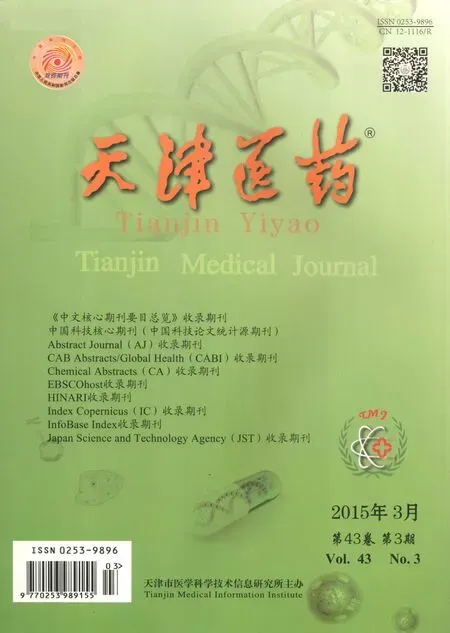凝血酶激活的纤溶抑制物与反复妊娠丢失关系的研究进展
易小芳,谭超
凝血酶激活的纤溶抑制物与反复妊娠丢失关系的研究进展
易小芳,谭超△
反复妊娠丢失(recurrent pregnancy loss,RPL)是常见于妊娠期的一种并发症,影响着2%的育龄妇女。最新研究发现高水平凝血酶激活的纤溶抑制物(thrombin-activatable fibrinolysis inhibitor,TAFI)可降低早期RPL发生的风险。TAFI是一种羧肽酶原,激活成活化型TAFI(TAFIa)后,能够使纤溶酶失去与纤维蛋白的作用位点而发挥纤溶抑制及调节血栓形成的作用。而纤溶系统的损坏是妊娠期妇女发生RPL的危险因素之一,关于TAFI与RPL的研究目前已经成为国内外医学界的研究热点之一。本文结合有关文献就TAFI近年来研究现状及与RPL的关系进行综述,旨在为临床治疗和预防RPL寻找新的方法和线索。
凝血酶;纤溶酶原灭活剂;流产,习惯性;综述;凝血酶激活的纤溶抑制物
反复妊娠丢失(RPL)是指连续3次发生在孕20周前的妊娠丢失(如自发性流产、胚胎停育及胎死宫内等现象),由于给孕妇及家庭带来巨大伤痛,逐渐被医学界重视,对其发病机制的研究也不断取得了新的突破。现研究认为凝血酶激活的纤溶抑制物(TAFI)是凝血和纤溶过程中的一个重要因子,与RPL关系密切,TAFI可能是影响了早期妊娠妇女体内的纤溶状态,高纤溶引起的血块加快解散可能反过来阻止受精卵有利地向子宫内移植,从而导致RPL。因此,利用TAFI抑制物对妊娠中由于血栓倾向造成的并发症进行早期的预防性治疗,对治疗或者预防RPL具有潜在的临床意义。
1 TAFI
1.1TAFI的生物学特性TAFI基因位于人13号染色体上,含11个外显子。TAFI与血浆羧肽酶原B、U及R同属于含金属锌羧肽酶家族。TAFI包括2个特殊结构域[1]:活性肽(Phe1-Arg92)域和催化域。活性肽域中的Phe1-Trp76区是由反向平行的α/β-折叠、4个α-链和2个α-螺旋构成的一个开放性夹心结构,并由一个连接域(Glu77-Arg92)连接到催化域上;催化域在α/β水解酶的作用下被折叠成8股β-折叠,两侧被α-螺旋包围。催化域内有一个动态的皮瓣区(Phe296-Trp350),具有较高的迁移率,由于皮瓣区是催化域的一部分,它可能与TAFIa的稳定性有关。
1.2TAFI的活化与抑制TAFI可被凝血酶、纤溶酶、凝血酶-血栓调节蛋白(T-TM)复合物、胰蛋白酶等水解裂解点Arg92-Ala93肽键而活化,激活成为TAFIa。TAFI的活化可导致活性肽的断裂,随后活性肽域和催化域相互的稳定作用中断,皮瓣区迁移率增高,最终导致构象改变而引起催化位点中断和精氨酸302凝血酶切割位点的暴露。通常认为T-TM复合物是最主要的激活物,而最新研究表明,高浓度的纤溶酶亦可高效激活TAFI[2-3]。活化后的TAFIa对热极不稳定,在体外37℃,半衰期仅为10~15 min,并且灭活的TAFIa易于聚集形成大的难溶的蛋白聚合物[4]。TAFIa自我调节机制可解释该酶半衰期之短,首先TAFIa不是通过蛋白质水解失活的;第二,催化锌离子并不是在失活过程中被释放的;第三,可能是活化TAFI时,活性肽域和催化域之间的连接键Arg92-Ala93断裂,但是活性肽仍连接在蛋白质的剩余物上造成的。到目前为止,还没有发现特异性的TAFIa天然抑制剂,如来自土豆的羧肽酶抑制物(CPI)不仅抑制TAFIa,也可稳定其催化域,减慢该酶由于构象改变而自发衰减的速度,具有促进和抑制纤溶的双重效果。除了TAFIa抑制剂外,大量的单克隆抗体和纳米抗体也可通过阻止TAFI的活化来抑制TAFIa的形成[5-6]。
1.3TAFI的合成与分布TAFI主要是由肝脏合成的,以酶原形式存在于血浆中,受肝脏中转录因子的调控。TAFI也分布在血小板内,并随着血小板的活化而分泌。尽管血小板TAFI仅占整个血液TAFI的0.1%,但在血栓形成的部位,血小板TAFI的释放可导致局部TAFI水平的增高。虽然血小板TAFI与血浆TAFI的糖基化方式有所不同,但它们的酶活性相似,表明巨核细胞是除肝脏外TAFI的另一个合成地[7]。
在过去几年里,已有大量的研究致力于血浆中TAFI浓度的测定,有学者报道在正常人体内,TAFI大约为4~15 mg/L,但平均值波动较大(45%~150%),意味着许多TFAI测试方法存在争议[8-9]。一般而言,TAFI血浆含量男性无年龄差别,而女性随年龄增长而增加;特别需要注意的是,女性妊娠时血浆TAFI可逐渐增高,妊娠20周时可达到高峰,并维持至分娩才迅速下降;此外,高胆固醇患者TAFI水平亦增高[10]。
1.4TAFI的主要生理作用血液凝固时,形成的纤维蛋白可与纤溶酶原、组织型纤溶酶原激活物(t-PA)形成三聚体,促进纤溶酶的形成,然后纤溶酶降解部分纤维蛋白暴露出新的赖氨酸残基,该残基作为纤溶酶在纤维蛋白上新的结合位点进一步刺激了纤溶酶的产生。而TAFI的激活降解了部分水解的纤维蛋白C末端的赖氨酸残基,使纤溶酶失去与纤维蛋白的结合作用位点而抑制纤溶[11]。纤维蛋白降解产物DD(E)片段也能够促进纤溶酶的产生,而TAFIa可使DD(E)片段与纤溶酶原tPA的亲和力下降,抑制了其促纤溶酶产生的作用。此外,高浓度TAFIa可直接抑制纤溶酶的活性,下调纤溶系统[12]。
Walker等[13-14]研究发现,TAFIa通过一个阈值依赖机制下调纤维蛋白的溶解。一旦TAFIa水平高于阈值,纤维蛋白溶解作用就保持在最初阶段,只有当TAFIa水平下降到阈值时,纤维蛋白溶解速率才以指数形式增加。其中,阈值受纤溶酶浓度的影响,而纤溶酶浓度又依赖于t-PA浓度和α2纤溶酶抑制剂浓度。
2 TAFI与RPL
TAFI/TAFIa在机体纤溶过程中起着重要作用,已引起动静脉血栓形成、缺血性发作、脓毒症、弥散性血管内凝血、肥胖、糖尿病、肝脏疾病、肾脏疾病及癌症等领域的广泛关注[15]。但其与妊娠的相关研究较少,多限于TAFI与妊娠高血压的关系,而随着TAFI晶体结构的阐述,TAFI与RPL的相关性也逐渐引起学者的重视。
Kayatas等[16]研究表明,TAFI水平与RPL没有关联性。Knol等[17]研究表明,高TAFI水平可能降低RPL发生的风险。Masini等[18]研究发现单核苷酸多态性(505A/A和1583A/ A)与TAFI水平增高及RPL风险降低都有关联。Pruner等[19]研究发现,+1040C/T多态性和C/C基因型与RPL风险降低有关联。然而,Martinez-Zamora等[20]认为,不明原因的RPL妇女体内纤溶系统损坏部分可用高TAFI水平来解释。
Legnani等[21]研究表明高TAFI水平能降低早期RPL发生的风险。这一作用可能的机制有两个假设:第一个假设是加速血块的解散可能反过来阻止受精卵充分地植入子宫内,在妊娠期间,尤其是妊娠的早期几周内,低纤溶的环境反而是有利的。同时,低纤溶可能与纤维蛋白溶解产物(FDP)的低水平有关,FDP能诱导胚胎滋养层细胞的凋亡[22],导致胎盘浅着床和蜕膜损害。第二个假设可能与TAFI调节补体介导的血管炎症有关,TAFI通过使炎症介质缓激肽和过敏毒素C3a和C5a失活来抑制机体炎症的发展,然而炎症过程在RPL的发展中起着重要的作用[23],所以高TAFI水平通过降低炎症反应来降低RPL的风险似乎是正确的。
3 RPL的诊治新进展
综上,检测TAFI水平有可能发展成为判断RPL合并症一项指标,也可能作为临床进行及早干预治疗的参考依据。已经有学者证明,TAFI活化只发生在纤维蛋白表面或附近,主要调节血栓局部的纤溶能力,对血栓局部以外的正常止血无明显的干扰,因此不会引起出血的危险,这就为TAFI治疗RPL提供了可能性。同时,可以利用TAFI抑制物对妊娠中由于血栓倾向造成的并发症进行早期的预防性治疗,对治疗或者预防RPL具有潜在的临床意义。
目前,国外学者已经通过重组TAFI阐述了其晶体结构,不仅提供了TAFIa失活过程的有关信息,而且为深入了解TAFI与其他疾病之间存在的联系及治愈更多的疾病患者提供更加坚实的理论依据[24]。TAFI与RPL的关系还存在争议,作为一种新的纤溶抑制物,虽然TAFI的生理作用尚未得到充分认识,却为凝血和纤溶之间提供了重要的联系。TAFI 对RPL是否具有保护作用应该引起研究者的关注,其在RPL中扮演的角色以及相关机制更值得探索。
[1]Marx PF,Brondijk THC,Plug T,et al.Crystal structures of TAFI elucidate the inactivation mechanism of activated TAFI:a novel mechanism for enzyme autoregulation[J].Blood,2008,112:2803-2809.doi:10.1182/blood-2008-03-146001.
[2]Vercauteren E,Emmerechts J,Peeters M,et al.Evaluation of theprofibrinolytic properties of an anti-TAFI monoclonal antibody in a mouse thromboembolism model[J].Blood,2011,117:4615-4622. doi:10.1182/blood-2010-08-303677.
[3]Mishra N,Vercauteren E,Develter J,et al.Identification and characterisation of monoclonal antibodies that impair the activation of human thrombin activatable fibrinolysis inhibitor through different mechanisms[J].J Thromb Haemost,2011,106(1):90-101.doi: 10.1160/TH10-08-0546.
[4]Vercauteren E,Gils A,Declerck PJ.Thrombin activatable fibrinolysis inhibitor:a putative target to enhance fibrinolysis[J].Semin Thromb Hemost,2013,39(4):365-372.doi:10.1055/s-0033-1334488.
[5]Hendrickx ML,Zatloukalova M,Hassanzadeh-Ghassabeh G,et al. Identification of a novel,nanobody-induced,mechanism of TAFI inactivation and its in vivo application[J].J Thromb Haemost,2014,12(2):229-36.doi:10.1111/jth.12473.
[6]Semeraro F,Ammollo CT,Gils A,et al.Monoclonal antibodies targeting the antifibrinolytic activity of activated thrombin-activatable fibrinolysis inhibitor but not the anti-inflammatory activity on osteopontin and C5a[J].J Thromb Haemost,2013,11(12):2137-2147. doi:10.1111/jth.12431.
[7]Shenkman B,Einav Y,Livnat T,et al.In vitro evaluation of clot quality and stability in a model of severe thrombocytopenia:effect of fibrinogen,factor XIII and thrombin-activatable fibrinolysis inhibitor[J].Blood Transfus,2014,12(1):78-84.doi:10.2450/ 2013.0068-13.
[8]Heylen E,Van Goethem S,Augustyns K,et al.Measurement of carboxypeptidase U(active thrombin-activatable fibrinolysis inhibitor)in plasma:Challenges overcome by a novel selective assay[J].Anal Biochem,2010,403(1-2):114-116.doi:10.1016/j.ab.2010.03.045.
[9]Santos IR,Fernandes AP,Carvalho MG,et al.Thrombin-activatable fibrinolysis inhibitor(TAFI)levels and its polymorphism rs3742264 are associated with dyslipidemia in a cohort of Brazilian subjects[J].Clin Chim Acta,2014,433:76-83.doi:10.1016/j. cca.2014.02.030.
[10]Watanabe T,Minakami H,Sakata Y,et al.Changes in activity of plasma thrombin activatable fibrinolysis inhibitor in pregnancy[J]. GynecolObstetInvest,2004,58(1):19-21.doi:10.1159/ 000077178.
[11]Philippou H.Thrombin activatable fibrinolysis inhibitor(TAFI): more complex when it meets the clot[J].Thromb Res,2014,133(1): 1-2.doi:10.1016/j.thromres.2013.10.034.
[12]Foley JH,Kim PY,Mutch NJ,et al.Insights into thrombin activatable fibrinolysis inhibitor function and regulation[J].J Thromb Haemost,2013,11 Suppl 1:306-315.doi:10.1111/jth.12216.
[13]Walker JB,Bajzar L.The intrinsic threshold of the fibrinolytic system is modulated by basic carboxypeptidases,but the magnitude of the antifibrinolytic effect of activated thrombin-activable fibrinolysis inhibitor is masked by its instability[J].J Biol Chem,2004,279 (27):27896-27904.doi:10.1074/jbc.M401027200.
[14]Leurs J,Nerme V,Sim Y,et al.Carboxypeptidase U(TAFIa)prevents lysis from proceeding into the propagation phase through a thresholddependentmechanism[J].JThrombHaemost,2004,2(3):416-423.
[15]Heylen E,Willemse J,Hendriks D.An update on the role of carboxypeptidase U(TAFIa)in fibrinolysis[J].Front Biosci,2011,16: 2427-2450.
[16]Kayatas S,Kumru P,Sariibrahim B,et al.Is thrombin-activatable fibrinolysis inhibitor antigen(TAFIag)level significant in recurrent miscarriage[J]?Clin Exp Obstet Gynecol,2014,41(4):448-450.
[17]Knol HM,Veeger NJ,Middeldorp S,et al.High thrombin-activatable fibrinolysis inhibitor levels may protect against recurrent fetal loss[J].J Thromb Haemost,2009,7(5):903-906.doi:10.1111/ j.1538-7836.2009.03336.x.
[18]Masini S,Ticconi C,Gravina P,et al.Thrombin-activatable fibrinolysis inhibitor polymorphisms and recurrent pregnancy loss[J]. FertilSteril,2009,92(2):694-702.doi:10.1016/j.fertnstert.2008.07.015.
[19]Pruner I,Djordjevic V,Miljic P,et al.+1040C/T polymorphism in coding region of thrombin-activatable fibrinolysis inhibitorgene and the risk of idiopathic recurrent fetal loss[J].Blood Coagul Fibrinolysis,2010,21(7):679-682.doi:10.1097/MBC.0b013e32833e426d.
[20]Martinez-Zamora MA,Creus M,Tassies D,et al.Thrombin activatable fibrinolysis inhibitor and clot lysis time in women with recurrent miscarriage associated with the antiphospholipid syndrome[J]. FertilSteril,2010,94(6):2437-2440.doi:10.1016/j.fertnstert.2010.02.032.
[21]Legnani C,Bovara M,Valdrè L,et al.Risk of early recurrent fetal loss and levels of thrombin-activatable fibrinolysis inhibitor[J]. ThrombRes, 2012, 130(2):237-241.doi:10.1016/j. thromres.2011.09.029.
[22]Guo YH,Hernandez I,Isermann B,et al.Caveolin-1-dependent apoptosis induced by fibrin degradation products[J].Blood,2009,113(18):4431-4439.doi:10.1182/blood-2008-07-169433.
[23]Kwak-Kim J,Yang KM,Gilman-Sachs A.Recurrent pregnancy loss:A disease of inflammation and coagulation[J].J Obstet GynaecolRes, 2009, 35(4):609-622.doi:10.1111/j.1447-0756.2009.01079.x.
[24]VercauterenE,GilsA,DeclerckPJ.Thrombinactivatablefibrinolysis inhibitor:a putative target to enhance fibrinolysis[J].Semin Thromb Hemost,2013,39(4):365-372.doi:10.1055/s-0033-1334488.
(2014-05-07收稿2014-11-02修回)
(本文编辑魏杰)
Advances on the relationship between thrombin-activatable fibrinolysis inhibitor(TAFI)and recurrent pregnancy loss
YI Xiaofang,TAN Chao△
The First Clinical Medical College,China Three Gorges University,Yichang 443002,China
△Corresponding AuthorE-mail:yczxyytanchao@sina.com
Recurrent pregnancy loss(RPL)is a common complication of pregnancy,which affects 2%fertile women.A recent research has found that high level of thrombin-activatable fibrinolysis inhibitor(TAFI)can reduce the occurrence risk of early RPL.TAFI is one kind of carboxypeptidase,which can be activated as TAFIa.TAFIa can make the fibrinolysin lose its working site,which can interact with the fibrin to play a role in the regulation of fibrinolysis and the inhibition of thrombus formation.The damage of fibrinolytic system is one of the risk factors for the occurrence of RPL in pregnant women,which has become one of the hotspots in the medical profession.In this paper,recent literature on TAFI and its relationship with recurrent pregnancy loss has been reviewed,hoping for new ways and clues in clinical treatment and prevention of RPL.
thrombin;plasminogen inactivators;abortion,habitual;review;thrombin-activatable fibrinolysis inhibitor
R714.2
ADOI:10.11958/j.issn.0253-9896.2015.03.028
湖北省自然科学基金(2014CFB307)
宜昌,三峡大学第一临床医学院检验科(邮编443002)
易小芳(1976),女,主管技师,本科,主要从事生殖免疫研究
△E-mail:yczxyytanchao@sina.com

